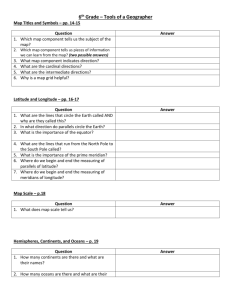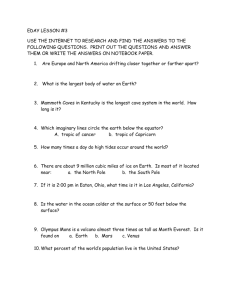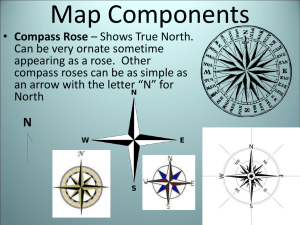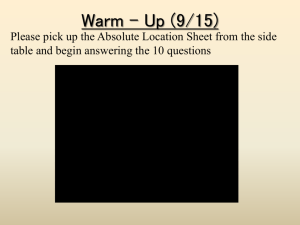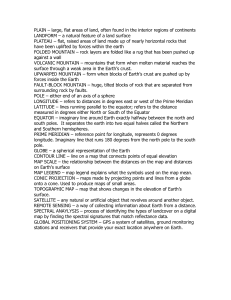Introduction to World Geography Notes
advertisement
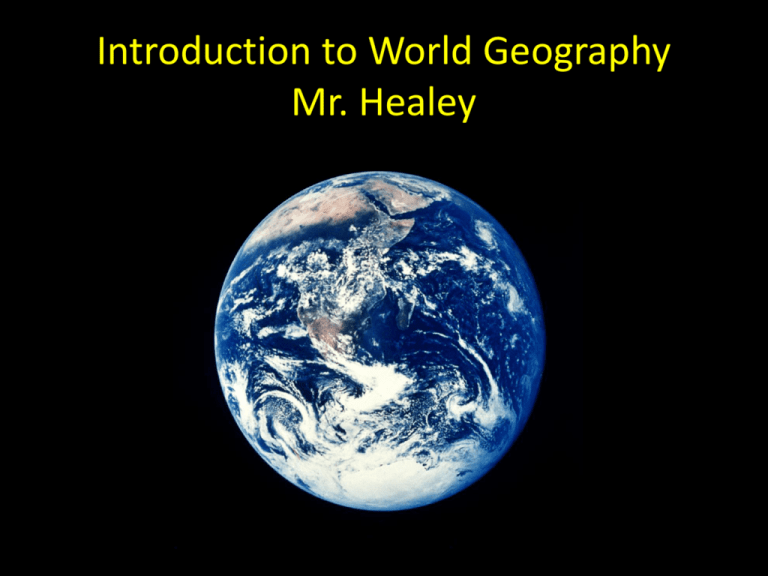
Introduction to World Geography Mr. Healey Equator Imaginary line that divides the earth into northern and southern hemispheres. It is expressed as 0° Latitude. Northern Hemisphere Equator Southern Hemisphere Prime Meridian Imaginary line that divides the earth into eastern and western hemispheres. Greenwich, England = 0° Longitude. Prime Meridian Eastern Hemisphere Western Hemisphere Latitude Lines (Parallels) Used to locate places north or south of the equator Lines run parallel to the equator Total of 180 lines of latitude 90° North 90° South Longitude Lines (Meridians) Used to locate places east or west of the Prime Meridian. Lines run from the North Pole to the South Pole. Total of 360 lines of longitude 180° East 180° West Longitude Lines and Time The distance between lines of latitude and longitude is approximately 70 miles. As the Earth revolves around the sun, different parts of the Earth are experiencing different times of day at the same time. For example, if it is twelve noon here, can the sun still be shining half-way around the world from our location? Of course the answer is NO! As the Earth rotates, both sides of the globe cannot be facing the sun at the same time. QUESTION: How do we tell what time it is around the world? ANSWER: We use lines of longitude to assist us. Lines of longitude can also mark the hours of the day as the Earth rotates. Every 15° east or west is equal to one hour. If it is 12 noon at the Prime Meridian, what is the time at the other meridians? North Pole O Degrees 30 W 15 W (Prime Meridian) 90 W South Pole 15 E 30 E 90 E Major Latitude Lines Equator = 0° Tropic of Cancer = 23.5° North Arctic Circle = 66.5° North North Pole = 90° North Tropic of Capricorn = 23.5° South Antarctic Circle = 66.5° South South Pole = 90° South Major Latitude Lines North Pole 90° North Arctic Circle 66.5° North Tropic of Cancer 23.5° North EQUATOR 0° Tropic of Capricorn 23.5° South Antarctic Circle 66.5° South South Pole 90° South Major longitude Lines Prime Meridian = 0° International Date Line = 180° Seasons As the Earth revolves around the Sun, it is tilted at 23.5° angle. Because of the Earth’s revolution and its tilt, different parts of the Earth receive the direct rays of the sun for more hours of the day at certain times of the year. This causes the changing of the seasons on the Earth. Vernal (Spring) Equinox Occurs when the sun is directly over the Equator. (March 21st ). Equal amount of day and night during a 24hour period. Earth is tilted at 23.5 degrees North Pole 90° N Sun’s direct rays strike the Equator Equator South Pole 90° S Summer Solstice Occurs when the sun is directly over the Tropic of Cancer (June 21st). Marks the longest day of the year in the northern hemisphere. New York City sees approx. 15 hours of light and 9 hours of dark. Sunrise = 5:25am Northern Hemisphere facing sun’s direct rays Sunset = 8:30pm North Pole 90° N Sun’s direct rays strike the Tropic of Cancer Tropic of Cancer 23.5° North South Pole 90° S Autumnal Equinox Occurs when the sun is again directly over the Equator (Sept. 23rd). Equal amount of day and night during a 24-hour period. Earth is tilted at 23.5 degrees North Pole 90° N Sun’s direct rays strike the Equator Equator South Pole 90° S Winter Solstice Occurs when the sun is directly over the Tropic of Capricorn (December 21st). Marks the shortest day of the year in the northern hemisphere. New York City sees the reverse in hours of day and night from the summer solstice. Northern Hemisphere tilted away from sun North Pole 90° N Sun’s direct rays strike the Tropic of Capricorn Tropic of Capricorn 23.5° South South Pole 90° S Aphelion The point at which the earth is farthest from the sun during its orbit. Occurs around July 3 when the earth is 94.5 million miles away. Perihelion The point at which the earth is closest to the sun during its orbit. Occurs around January 4 when the earth is 91.4 million miles away.


